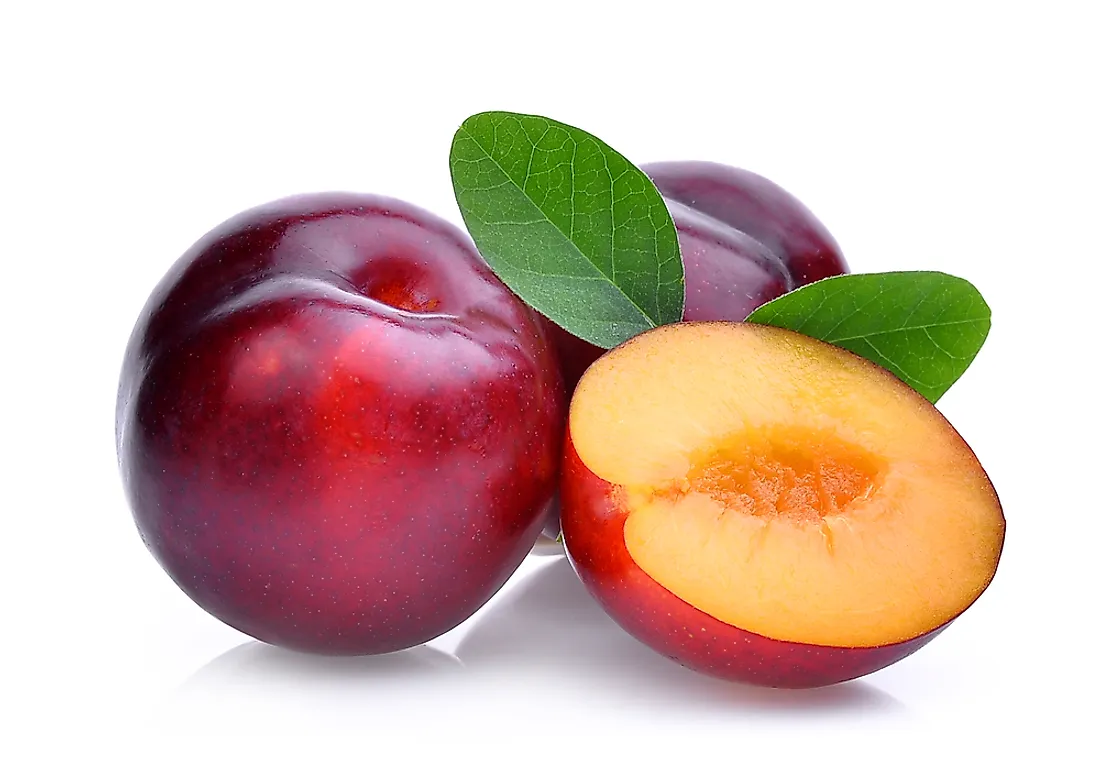Where Do Plums Grow?

The plum is a fruit of both the subgenus and genus Prunus. The plum's subgenus is differentiated from other subgenera species such as bird cherries, peaches, and cherries in the shoots having individual side buds and terminal bud, the flowers in groups of one to five congenial on short stems and fruits that have a groove running down one side with a smooth pit or stone. Mature plum fruits can have a dusty white waxy membrane that gives the fruit a glaucous look. Dried plum fruits are either called prunes or dried plums even though prunes are a different type of plum and may have preceded the fruits today commonly known as plums.
The Plum Tree
Plums are a versatile group of species with the commercially significant plum trees being medium-sized and are mostly pruned to five or six meters high. Plum trees have a medium hardiness, and without pruning, they can reach a height of 12 meters and spread across to 10 meters. Plums blossom during different months in different parts of the world for instance in Taiwan they blossom around January while in the United Kingdom they blossom in early April. Plum fruits usually have a medium size of about one to three inches in diameter, and its flesh is firm and succulent. The plum fruit has a smooth peel and a natural waxy surface that is attached to the flesh. The plum fruit is a drupe which means a single hard seed is surrounded by the fleshy part of the fruit.
There are about 19 to 40 species of plums.
Benefits And Uses of Plums
Plum fruits contain antioxidants which may be helpful in treating cancer, diabetes, and obesity. Plums are packed with a variety of nutrients such as minerals and vitamins that add a great deal of nutritional value and healthy benefits. Plums also have a significant supply of dietary fiber and contain very low calories that do not have harmful fats. Plums are used as a fresh fruit and can also be used in manufacturing jam or other recipes. Plum fruits are used to make juice, and the juice can be fermented to make plum wine. Saladito is a snack made of dried salted plums.
Cultivation And Production Of Plums
The plum tree flowers in early spring with approximately 50% of the flowers being pollinated and developing to become plums within a year. Plum trees start to flower after 80 growing days. The climate that is too dry can hinder the development of plums past a certain stage, and instead, the fruits start to fall off from the tree while they are still small. If the plums are not harvested early enough before they are ripe, the fruit could be attacked by brown rot fungus. Plums are globally produced, and China is the world's largest producer. Despite plums being produced across the world, some countries have a different version of what they call plums as compared to the fruits in the Americas and Europe.
The Top Plum Producing Nations
Plums are edible fruits with great nutritional value. China, India, and Serbia are three top producers of plum in the world. China is the top producing country accounting for 6,663,165 tons followed by Romania with 512,975 tons and Serbia with 463,115 tons. Other top plum producing countries include the United States, Turkey, Iran, India, Spain, and Italy.
The Leading Producers Of Plum In The World
| Rank | Country | Production (tons) |
|---|---|---|
| 1 | China | 6,663,165 |
| 2 | Romania | 512,975 |
| 3 | Serbia | 463,115 |
| 4 | United States | 392,537 |
| 5 | Turkey | 297,589 |
| 6 | Iran | 269,113 |
| 7 | India | 261,903 |
| 8 | Spain | 222,020 |
| 9 | Italy | 220,729 |
| 10 | France | 211,269 |











